
Trip Report: Crossing the Pacific in ANA’s Boeing 787-9 Business Class
On a recent trip to Asia, I had the opportunity to fly in Business Class on an All Nippon Airways…

My aircraft for today, N835MA, a Cessna 208 Grand Caravan (Photo: AirlineGeeks | Joey Gerardi)
This will probably sound like a broken record for avid AirlineGeeks readers, but in the Spring of 2022 SkyWest under the United Express brand requested to terminate 31 Essential Air Service communities. Now at least six months later, some of them have said that SkyWest isn’t allowed to leave, some have chosen a new carrier and have already started service with that new carrier and some, like the community in this trip report, have selected a carrier with service scheduled to start this fall.
Muskegon County Airport in Michigan, located on the western shore of the state along Lake Michigan and roughly 45 minute away from much larger Grand Rapids Airport, is in a weird position. One of the main rules of EAS is that they have to be located more than 70 miles from a medium or large hub city, Grand Rapids is closer than that, but it hasn’t hit the medium-sized threshold yet.
Just before the Covid-19 struck the United States in March of 2020 the airport was nearing that benchmark, and with travel rebounding, they are nearing it again. Another rule about EAS contracts is that airports have a clause saying they must have multi-engine aircraft service, but the airport can waive that right. out of the 31 airports, SkyWest has requested to leave, Muskegon is the only airport of the group to waive their right to dual engine operations, which also means they automatically waived their rights for it in future EAS contracts.
However, with Grand Rapids nearing the medium hub-sized classification, this could very well be the last EAS contract the community will be awarded if Grand Rapids is large enough the next time Muskegon’s EAS contract is up for rebidding four years from now in 2026. So that single engine waiver may mean nothing in four years
Once they lose eligibility it will be up to the current airline there whether or not it would like to stay without the EAS subsidies. The community leaders in Muskegon are being very smart and open-minded about this, get an airline to establish a connection with the community and build up passenger numbers so that not if, but when they lose subsidies, maybe they’ll stay. Half of the 31 EAS cities that have decided to go with other airlines aren’t at risk of losing eligibility, so they have stood firm with not waiving their dual-engine rights.
But, for now, Southern Airways Express will serve Muskegon from Chicago’s O’Hare International Airport with 36 round-trip flights per week according to the EAS contract it were awarded. All flights are scheduled to be on one of the airline’s many eight to nine seat Cessna 208s.
Fall and more specifically Oct.1 is one of the more common dates that EAS contracts start on. Exactly two years ago on Oct. 1, 2020, I participated in Cape Air’s inaugural flight out of Manistee, Mich. which is located less than two hours north of Muskegon. Manistee is also an EAS community.
The day before the flight, around 7 p.m. I got a phone call from one of the airline employees reminding me I had a flight booked with them. This is not uncommon for smaller commuter airlines to get a personal text or call reminding them of the flight. I got a call the night before my Cape Air flight out of Manistee, and someone from Southern Airways Express sent me a text message the morning of my flight from LAX to Imperial, Calif.
For the sake of not typing the entire airlines name every time, I will refer to ‘Southern Airways Express’ simply as ‘SAE’ in the remainder of this article.
The inaugural departure from Muskegon was scheduled for 5:45 a.m. and with a departure in the early morning the doors were sure to be locked overnight, but I wanted to make sure I was first to check in, so I arrived earlier than I probably should of at 3:40 a.m. The first airline employee didn’t arrive and unlock the terminal doors until around 4:20 a.m., and the few passengers for the flight started to trickle in, six to be exact for this first flight. Even in the dark, you could see that the airport was a striking green color, and looked like something that belongs in the Wizard of Oz.
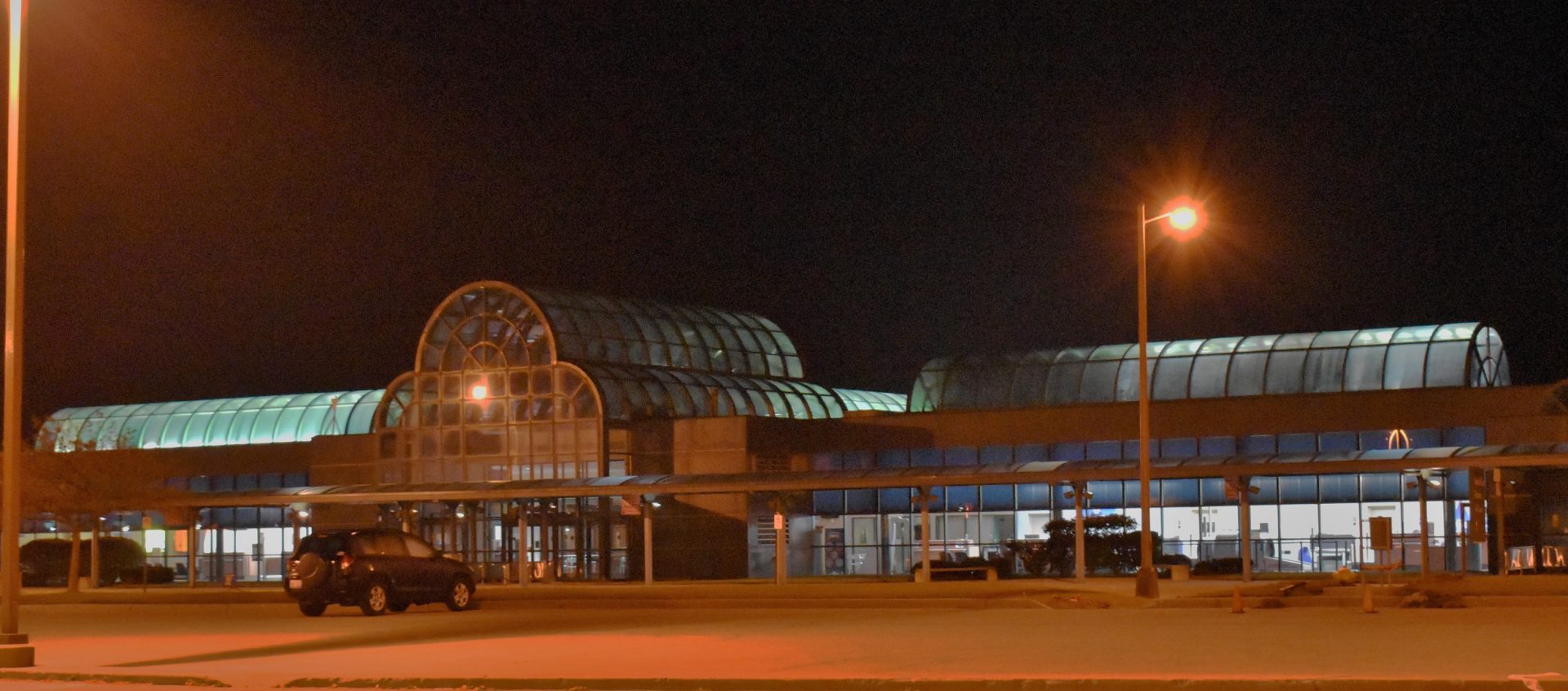
The Muskegon County Airport (Photo: AirlineGeeks | Joey Gerardi)
With commuter airlines like this, especially ones that have interline relationships, it is always interesting hearing the stories from the passengers on what airline they think they are flying on before, they realize they will be on an eight or nine seat propeller plane. Me and one other person were just going to Chicago, three of the passengers booked it on American’s website and had onward connections, and the last passenger booked it with United and had an onward connection as well.

Southern Airways Express counter in Muskegon (Photo: AirlineGeeks | Joey Gerardi)
Despite United/SkyWest only leaving the day before, they had already stripped away all of the logos and anything that showed they were ever here and the SAE name and logo is what remained the morning of the first flight. As with all airlines that fly smaller planes like these, they asked everyone their body weight and weighed all bags and items that were going on the plane. This is so the pilots can seat us where they need to in the cabin for weight and balance purposes.
There are three types of bags on this flight: checked, carry-on and valet. Checked bags are given to the airline when you check-in and you get them back at baggage claim at your final destination, carry-on bags for this plane are smaller items like purses or small backpacks that can sit at your feet, anything bigger than that will be valet as this plane has no under-seat storage or overhead bins to speak of.
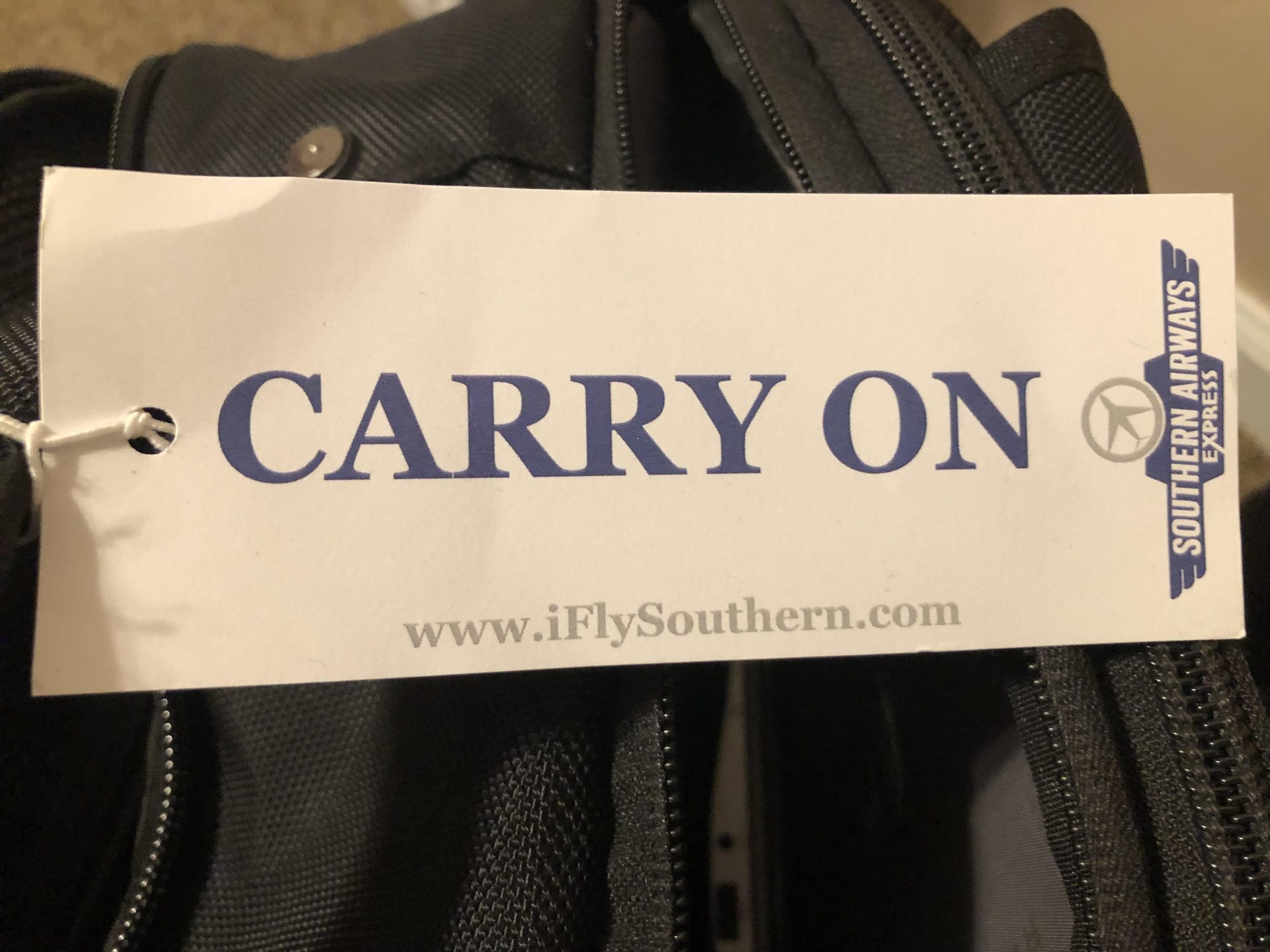
The tag they put on my backpack (Photo: AirlineGeeks | Joey Gerardi)
As with any airline’s first day in a new city, the employees were still learning the systems and getting used to all the ins and outs of a new software. I tried to get my TSA PreCheck number added to my boarding pass, but they couldn’t figure it out, since it was a smaller airport it didn’t matter because there was no long line, but it would’ve been nice to not remove my laptop, camera gear and other such items from my bag. I would like to note than I was the first person to ever check-in for a SAE flight in Muskegon, seen on my boarding pass as “SEQ 001,” a unique distinction that I also got on Cape Air’s flight out of Manistee two years prior.

My boarding pass for the inaugural flight (Photo: AirlineGeeks | Joey Gerardi)
As it was a small plane they didn’t need to board 30 minutes prior like the boarding passes read, and the TSA checkpoint didn’t even open until 30 minutes prior anyways. An interesting note to add about this airport is they don’t have a restroom in the gate area past security, and with the plane also not having a restroom, that means the lobby of the airport was the last chance to use it until we got to Chicago an hour and a half later.

The area just before the TSA Checkpoint (Photo: AirlineGeeks | Joey Gerardi)
The gate area wasn’t big and has roughly 50 or 50 seats, perfect for the CRJ-200’s that used to operate here but overkill for the Cessna 208’s that now operate to the airport. The gate area also has two gates each of which are equipped with a jetway, which now probably won’t be used for a long time. I would like to note that they do receive casino/gambling charters on Sun Country Boeing 737’s every eight months or so, but those haven’t been seen since before the pandemic began.

The gate area at MKG (Photo: AirlineGeeks | Joey Gerardi)
Under the Gate 1 sign, it had the Southern Airways Express logo along with the three airlines they had interline agreements with: American, Alaska and United. Passengers could check their bags to either three of the airlines going to or from Muskegon.
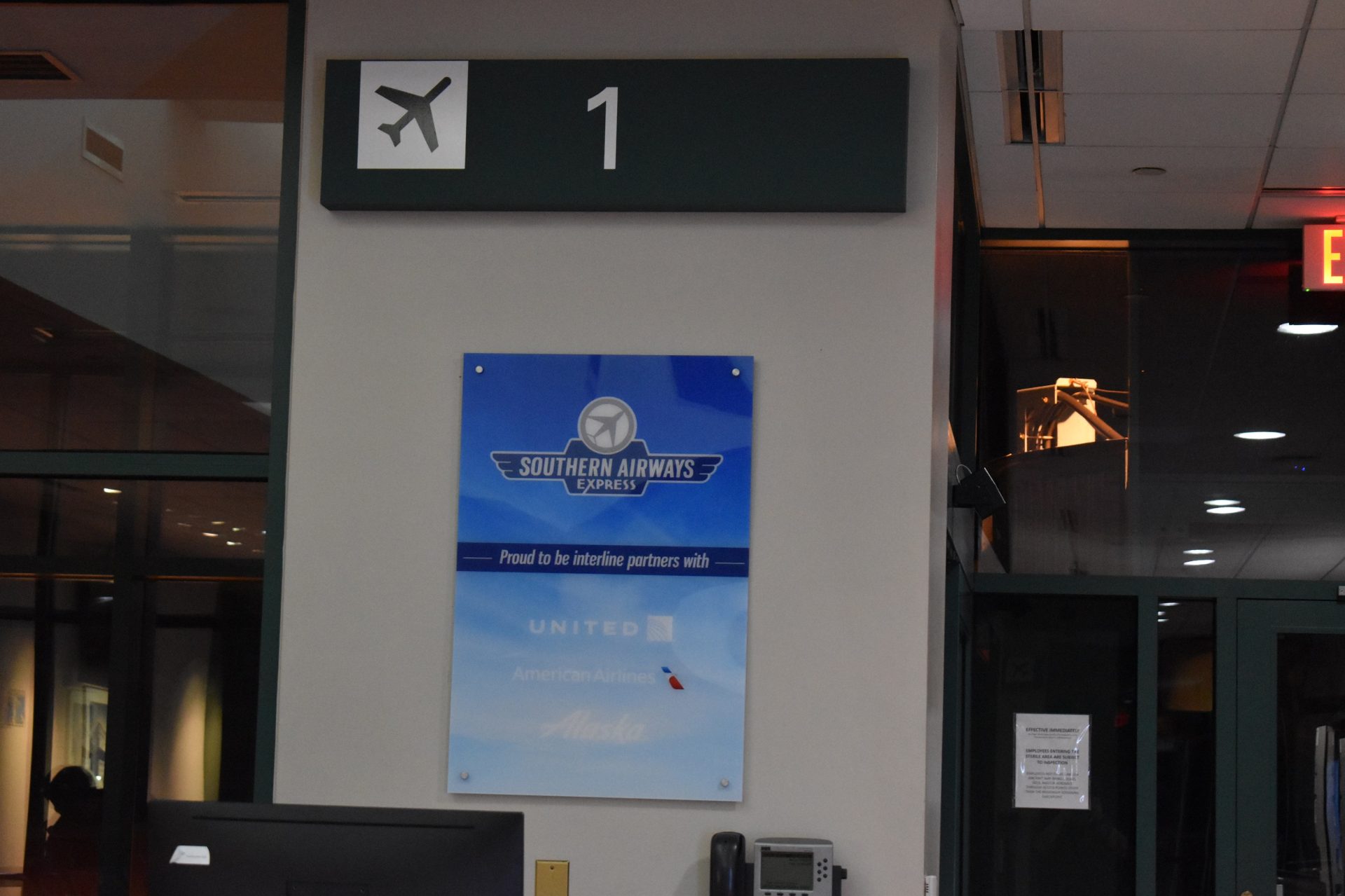
Sign depicting the airlines interline agreements (Photo: AirlineGeeks | Joey Gerardi)
It is also interesting that neither the airline nor the airport had set up any type of fanfare or celebration, given this is the airlines first time operating out of Muskegon, and the state of Michigan as a whole I did expect at least a little something even at five in the morning. However I did hear employees say, “This is it, first one!” a couple of times, but other than that there was nothing different from this flight and every other flight they’ll take out of here for the next four years. A little disappointing, as I have attended a bunch of inaugurals in the past, this is the first without a celebration of any sort.
About 10 minutes before departure time we were ushered outside and got on board our aircraft for the inaugural flight. My aircraft is a nine-seat Cessna 208 Grand Caravan that carries the registration of N835MA, and there is actually a bit of a fun fact about this tail number, I have encountered it before.

My aircraft for today, N835MA, a Cessna 208 Grand Caravan (Photo: AirlineGeeks | Joey Gerardi)
Over two years ago I flew to the EAS community of Imperial, Calif., a town located along the U.S.-Mexico border and although I didn’t fly on it, this plane was sitting on the tarmac. The one large difference is that the last time I saw the plane, it was still wearing the Mokulele Airlines livery of which SAE merged with just months before that flight.
The seat numbers were labeled with pieces of paper taped just above the windows, I was given seat 7, a seat on the left side of the plane. Safety briefing and engine startup, when we taxied out to the runway he didn’t talk to ATC, but instead himself. In Muskegon and other similarly sized airports around the country, the ATC is closed from 11 p.m. to 6 a.m. local time, so outside of that time pilots and aircraft just say what they are doing over frequency and go, then contact the center once in the air. The audio of this can be heard in the video of I made of this trip, located at the end of this article.
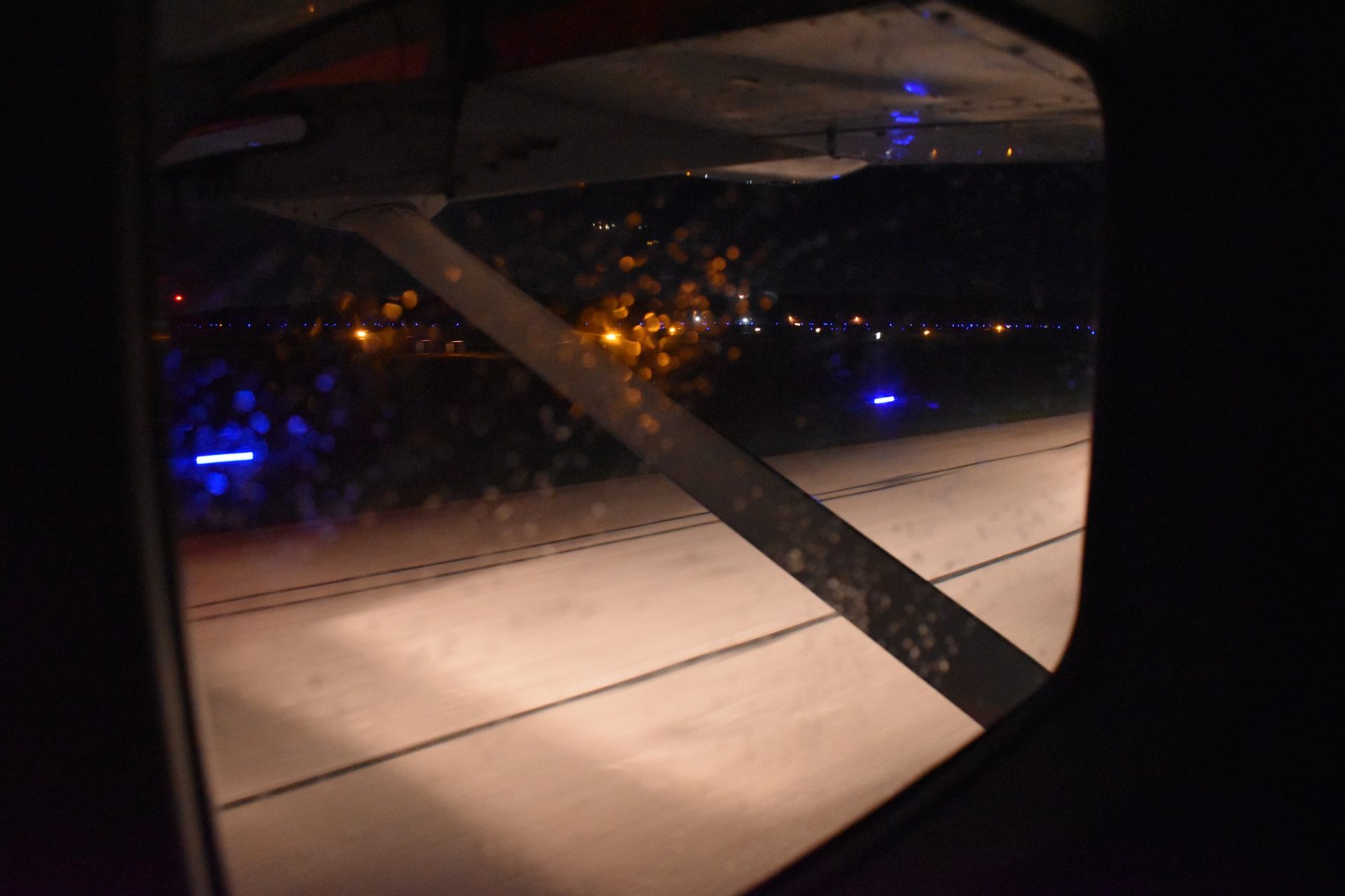
taxiing out to the runway in Muskegon (Photo: AirlineGeeks | Joey Gerardi)
Taxi was normal and we took off into the dark early morning sky towards Chicago. Another interesting aspect that makes it different from the airline previously here is the route they take to get to Chicago. When SkyWest/United was here with the CRJ-200 they flew directly over the lake, but not SAE. Due to the size of Lake Michigan, and that we were using a single engine unpressurized plane, we had to fly relatively close to the shore of Lake Michigan for the entirety of the flight. This also meant the flight time would be at least double what it took on the CRJ-200 with United.

On takeoff roll leaving Muskegon (Photo: AirlineGeeks | Joey Gerardi)
The windows on the Cessna 208 are relatively large — definitely larger than the windows on the CRJ-200, which was great for people on the left side of the aircraft especially during hours when it’s dark. The lights of the cities and communities we passed illuminated our way, although not literally since GPS exists, but it was still nice seeing the lights along the route.

Just after taking off from Muskegon (Photo: AirlineGeeks | Joey Gerardi)
Even though sunrise was still more than an hour away, once we got up into the sky people on the left could start to see the glimpse of a bring spot in the sky which glowed a very dull orange color. Along the way we passed South Haven, and Benton Harbor along with other smaller cities that shined so dull we could hardly see them. It is so beautiful seeing all of the communities, and with the complete darkness you can clearly see the edge of the lake with the light shining around it.
Roughly halfway through the trip, those on the right side of the plane could start to see the other end of the lake shining brightly even though it was still a good distance away.
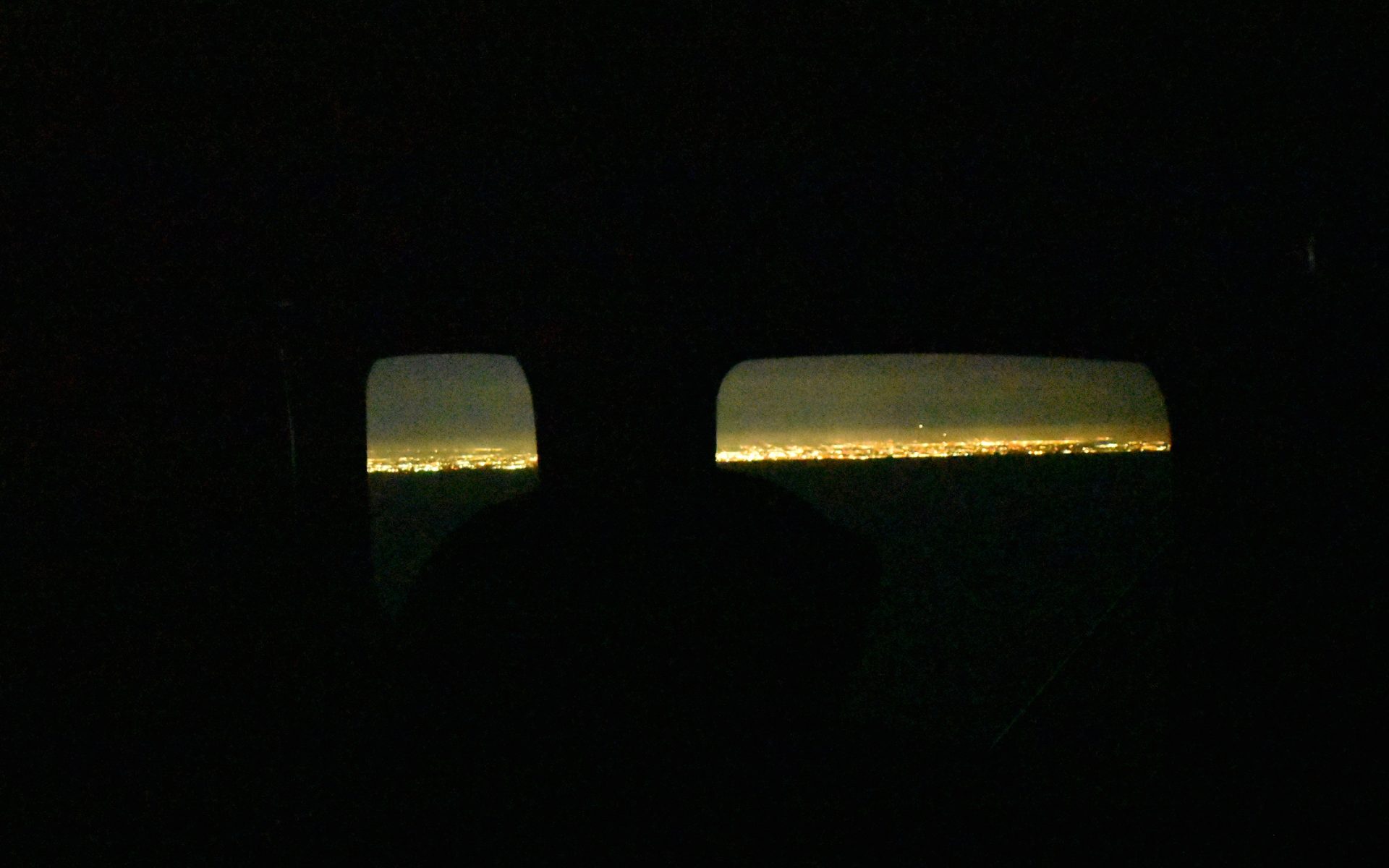
The west side of the Lake Michigan shoreline (Photo: AirlineGeeks | Joey Gerardi)
With the open cockpit, except for some dividers just behind the seats, you could stare directly into the cockpit and see the GPS and tracking equipment which shined a bright light back into the cabin.
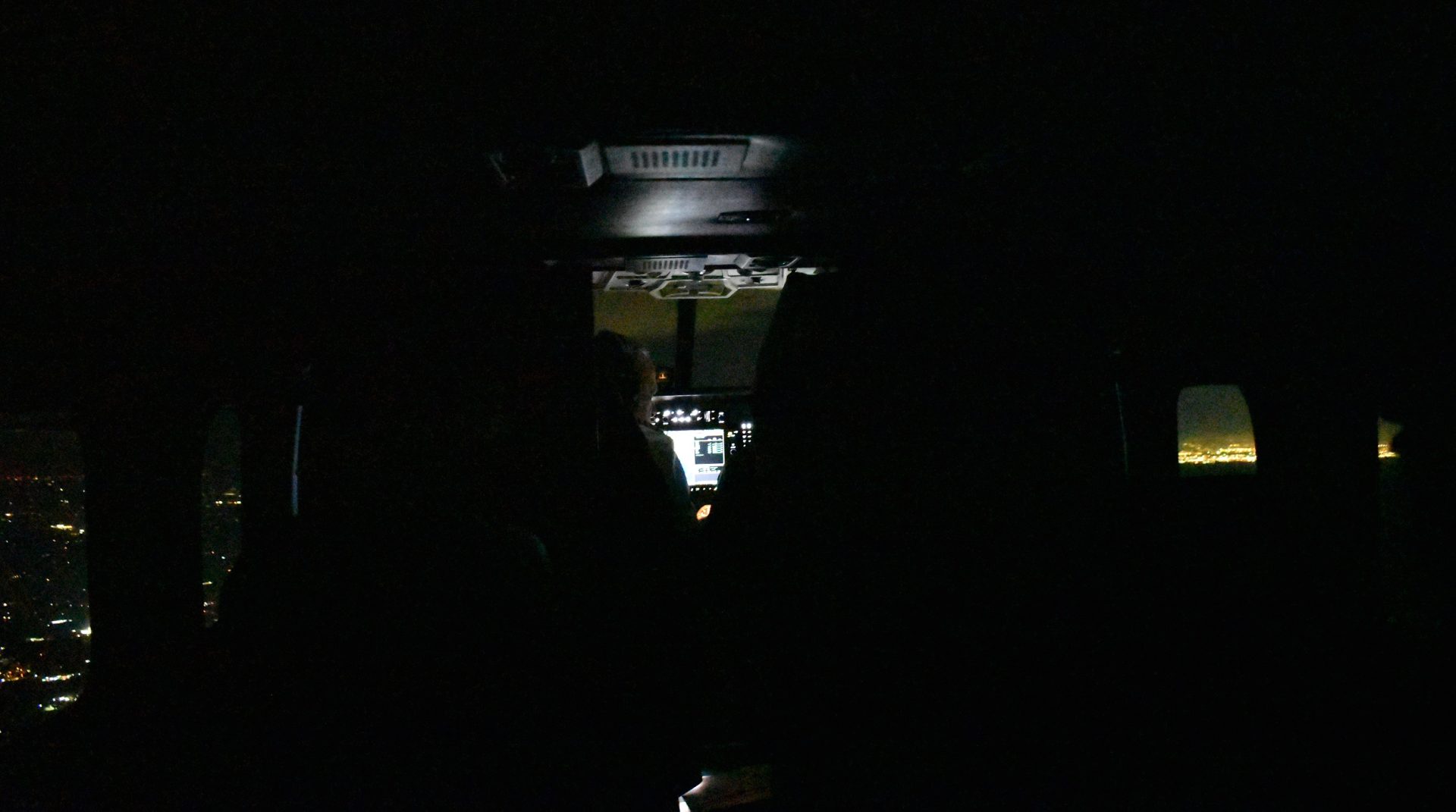
Looking into the cockpit from the passenger cabin (Photo: AirlineGeeks | Joey Gerardi)
We then passed over Michigan City, Ind., which was the brightest and biggest city we have seen since we left Muskegon.

Flying over Michigan City, Indiana (Photo: AirlineGeeks | Joey Gerardi)
It wasn’t long before we were flying over the Chicago suburbs. Both sides of the aircraft had a spectacular view — the left side could see Midway Airway and the right side could see downtown Chicago.

Chicago Midway from above (Photo: AirlineGeeks | Joey Gerardi)
Luckily someone on the right side was nice enough to learn back a good bit so I could get a shot of the Downtown Chicago skyline, one of the most beautiful sights you’ll see. This is a premium example of why a slower and lower flying plane like this Cessna 208 is the most fun option of flying into and out of bigger cities.

The Downtown Chicago Skyline in the dark (Photo: AirlineGeeks | Joey Gerardi)
You could also see O’Hare out of the right side of the aircraft. Another interesting aspect of flying a smaller plane into a large airport like O’Hare is how small compared to everything else you are, we didn’t start descending from out cruising altitude of 8,000-feet until we were over the suburbs. And we were still flying at our cruise speed of between 160-180 knots until we were on final to O’Hare. Because all of the other planes are moving so much faster, we need to keep our speed up until we got really close to the airport.
As we turned back to the east to land, you could see the sun coming up further out of the cockpit windows as well as the runway we were to land on.

On approach to Chicago O’Hare (Photo: AirlineGeeks | Joey Gerardi)
We touched down on runway 10C at 5:56 a.m. and completed the flight in 1 hour and 7 minutes. The flight is scheduled as 1 hour and 50 minutes, meaning we arrived pretty early into Chicago. It was also a double inaugural flight for the airline and me. As this is SAE’s first route into O’Hare it makes it the first scheduled flight of theirs to touch down at the airport.
We then taxied into gate F4, which was a shock to me as I thought all of the commuter airlines used the ground boarding gate L11A in American’s terminal. Gate F4 is among United regional jet gates, meaning we were among flights to other EAS communities. It is a perfect spot as it is right on the edge between the United and American gates, with Alaska’s gate not far from them either, making it perfect for those connecting to any of the three airlines they interline with.

Southern Airways Express’ parking spot at F4 (Photo: AirlineGeeks | Joey Gerardi)
They brought us into a door on the ramp and we took an elevator ride up into the terminal and it dumped us out in the middle of a bank of United Express gates, and conveniently right next to a United flight departure board.
For those traveling on with American, Alaska or any other airline except for United and Air Canada, they had to use the airlines app of ask a SAE staff member to point them in the right direction for their next flight. This is due to it being a United gate area and no flights showing up on the board except theirs and close Star Alliance partners like Air Canada.
As this was SAE’s very first day in Chicago, they didn’t show up on any departure board at the airport at all. An airline staff member said they were working with the airport to get that changed and get them added. Once fixed their flight will appear on every board at the airport, from American and United’s to the smaller board in the L gates for the commuter airlines and Spirit. That way all connecting passengers will be able to find them, even if they aren’t coming from an interline partner airline. One passenger had that problem the morning of the flight as he was coming from Spirit Airlines, and most non-Southern employees at the airport have never heard of the airline before.
There is also no SAE logo or any signs showing Muskegon anywhere at gate F4, again since it is their first day they don’t have everything set up yet and they are working on it. I was then given my boarding pass for the return flight and they checked my ID, they got my body and bag weight from the agents in Muskegon.

The gate Southern will be using at Chicago O’Hare (Photo: AirlineGeeks | Joey Gerardi)
Flashforward to roughly 7 a.m., the flight back to Muskegon is scheduled to leave at 7:10 a.m. but we were informed the flight would be delayed by 30-minutes. This is due to their fuel supplier, Swissport, showing up with the wrong connector to fuel the small Cessna 208 and having to go back and get a different one so they could fuel.
After the 30-minute fuel delay, I and the three other passengers boarded the plane back to Muskegon which would this time be during the daylight. Same as last time, most of the other passengers didn’t know what they were getting onto, and because there was a jetway blocking the window, they didn’t see it until we got outside. This lead to some pretty funny reactions on the ramp, especially considering one of them has flown United into Muskegon before and didn’t expect anything different.

Heading back out to the same plane that brought me here (Photo: AirlineGeeks | Joey Gerardi)
Same as before, safety briefing and engine startup, we then began to taxi out to our departure runway of 10L with me this time sitting in seat 6 on the right side. It is amazing how small we were even compared to a 50-seat jet, but the size really does show once you get behind a Boeing 737 or a plane even bigger.
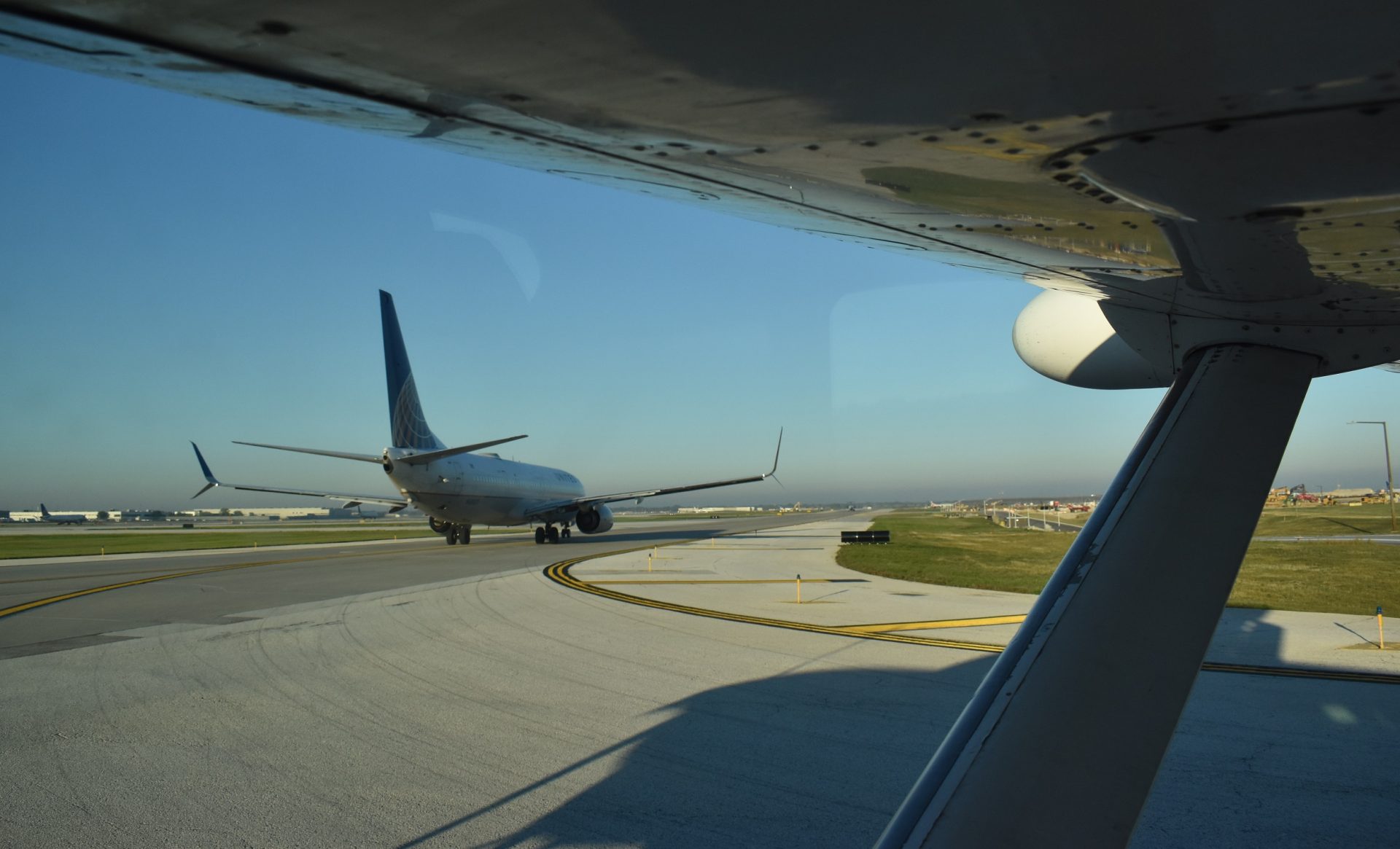
Taxiing behind a United 737 (Photo: AirlineGeeks | Joey Gerardi)
We then took off from 10L with planes taxiing on the sides of us. For those of us like myself that can’t afford those pricey helicopter spotting sessions over large airports, the slower nature of this plane makes it perfect to get those shots of planes taxiing below us, this is another benefit of having a high-wing aircraft like this.

Taking off from Chicago O’Hare (Photo: AirlineGeeks | Joey Gerardi)
For the reverse flight those on the right side can see Chicago Midway, and those on the left can see downtown Chicago. A couple of minutes after takeoff those on the right will also be able to see Chicago-Gary Airport below. While looking down at Gary, I noticed something I somehow forgotten until now, the fixed landing gear.

Flying over Chicago-Gary Airport (Photo: AirlineGeeks | Joey Gerardi)
The fixed landing gear on the Cessna 208 is just another unique aspect of this plane, it’s not often passengers get to look directly at the landing gear from the inside of the cabin while landing, without seeing them from a camera like on the Airbus A350.
The daylight also gave me a chance to look around the cabin and at the airlines magazine, which contains a depiction of the fleet types SAE operates and a route map. You can also see the cockpit a little better, although I didn’t notice how much the barriers obstructed it until the sun came up, but you can still see the GPS from the back so that’s good.

Looking forward from the passenger cabin (Photo: AirlineGeeks | Joey Gerardi)
At some point shortly after flying past Michigan City, I fell asleep and didn’t even realize it until I woke up and we were flying over land with the airport in the near distance. These small planes tend to rock people to sleep, and it shows because at one point all four of the passengers were asleep, but I was the only one that woke up before we landed.

Muskegon County Airport out of the left side of the plane just before landing (Photo: AirlineGeeks | Joey Gerardi)
We touched down at 9:46 a.m. after a 1-hour, 4-minute flight, only one minute behind schedule which is good considering our delay leaving Chicago. Once we touched down the other passengers woke up, also surprised that they fell asleep.
Despite the lack of celebration and fanfare for an inaugural, it was a great flight with the only real problem being the fault of the fueling company in Chicago.
Time to compare SkyWest and SAE, as they definitely both have ups and downs. First, the ease of booking. I know about Southern, so I went directly through their website, but most people don’t know they exist especially with them being new to the area. Most will book the flight through a larger carriers website like American, Alaska or United.
For ease of connections, the interlines are a big plus with the new carrier, with American, Alaska, and United having baggage agreements with SAE. It will be even easier than before and passengers will now have more options for connections with two of their three interline partners having a hub at O’Hare. And they won’t be loosing any connections as you can still connect to flights on the previous carrier that served here, United.
United MileagePlus members can’t earn miles for the Muskegon segment of the trip and neither will members of the other two airlines they interline with, which isn’t a huge deal as it is such a short route and will only be an inconvenience at most. However the high rollers from United will see that as a bigger letdown and will probably drive to nearby Grand Rapids, but that number will probably be relatively low.
The CRJ-200 is definitely faster than a Cessna 208, and the trip now takes at least twice the time as before with United averaging around 30-35mins for the flights to Chicago before they left, and just my two flights with Southern both being over one-hour. The smaller planes obviously hold less, and with only eight to nine seats per plane four to six times per day, they can only take a maximum number of passengers around 50-54 per day to Chicago, but with United’s average load during the summers being close to 50% there shouldn’t be much in the way of people not having seats available. If it does happen, Grand Rapids is not that far away and the United operation there can more than support a couple passengers leaking over from Muskegon.
SAE’s flight schedule is much better, with four to six flights a day. The earliest departure is around 5:45 a.m. and the last arrival comes in close to midnight, offering much better options in terms of connectivity in Chicago and timing of flights. Prior to pulling out, United’s first flight of the day from Muskegon left around 1 p.m. and their last arrival every day left Chicago at around 1 p.m. getting into Muskegon at 3 p.m. which wasn’t great for anyone making an early/late flights or those wanting to do a day trip.
The winter will be interesting to watch, historically when airlines need to lower the number of landing slots the shorter flights making less money tend to go first, like Muskegon, saving the slots for larger planes that seat hundreds of people. But with SAE having an independent operation hopefully their weather cancellations will be at a minimum, although that is a prediction and only time will tell for that.
United does have it’s upsides and Southern has it’s downsides, but overall it seems like Southern Airways Express is the better fit for Muskegon. Especially with them at risk of losing EAS funding as Grand Rapids grows, they need a carrier that is possibly willing to stay once the government EAS money ends.
A video account of this trip can be found below:
Joe has always been interested in planes, for as long as he can remember. He grew up in Central New York during the early 2000s when US Airways Express turboprops ruled the skies. Being from a non-aviation family made it harder for him to be around planes and would only spend about three hours a month at the airport. He was so excited when he could drive by himself and the first thing he did with the license was get ice cream and go plane spotting for the entire day. When he has the time (and money) he likes to take spotting trips to any location worth a visit. He’s currently enrolled at Western Michigan University earning a degree in Aviation Management and Operations.
Receive a daily dose of the airline industry's top stories along with market insights right in your inbox.

On a recent trip to Asia, I had the opportunity to fly in Business Class on an All Nippon Airways…

Hawthorne, Calif.-based Advanced Air has been slowly but modestly increasing air service in the southwestern part of the country adding…

Icelandair serves many destinations in North America, and even more in Europe. The airline offers an extensive stopover program that…



